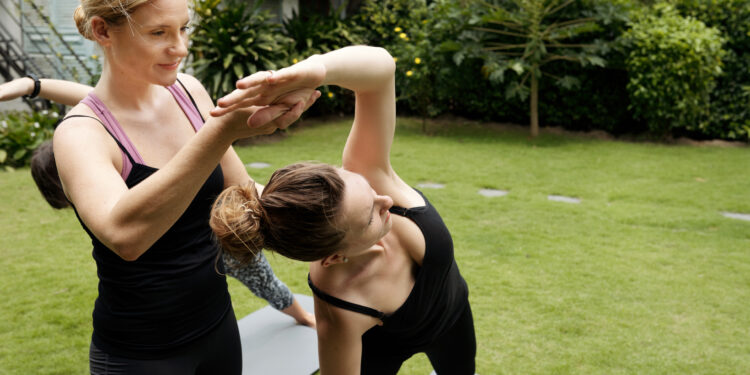Yoga has grown into a global phenomenon, attracting millions who seek physical fitness, mental clarity, and spiritual growth.
For passionate practitioners, a natural question arises: should you pursue formal yoga teacher training, or is self-learning enough to deepen your practice?
Both paths have unique benefits and challenges. In this article, we’ll explore the differences, advantages, and considerations for each, while highlighting why many students choose a yoga teacher training in Rishikesh for a more structured, immersive experience.
1. Understanding Self-Learning in Yoga
Self-learning in yoga typically involves:
- Practicing at home using online classes, videos, or books
- Attending occasional workshops or group classes
- Exploring yoga philosophy independently
Pros of Self-Learning:
- Flexibility: Practice anytime, anywhere, at your own pace
- Cost-effective: Minimal expenses compared to formal training
- Exploration: Freedom to try different styles, teachers, and techniques
Cons of Self-Learning:
- Lack of guidance: Mistakes in alignment or technique can lead to injury
- Limited understanding: Many miss out on deeper philosophy, anatomy, or teaching methodology
- Less accountability: Motivation can wane without a structured schedule
Self-learning works well for personal growth, but those seeking to teach or gain comprehensive knowledge often need more structured training.
2. What Formal Yoga Teacher Training Offers
A 200 hour yoga teacher training in Rishikesh provides a structured, immersive program that combines theory, practice, and lifestyle learning.
Core Components Include:
- Asana practice: Correct alignment, sequencing, and advanced postures
- Pranayama and meditation: Breathwork, mindfulness, and mental focus
- Yoga philosophy and history: Ancient texts, ethics, and spiritual context
- Anatomy and physiology: Understanding the body for safe practice
- Teaching methodology: Skills to lead classes, give adjustments, and develop sequences
Benefits of Formal Training:
- Guidance from experienced teachers: Direct feedback ensures correct technique and understanding.
- Structured progression: A clear curriculum builds knowledge systematically.
- Immersive environment: Many programs in Rishikesh include living in an ashram-like community, fostering discipline, mindfulness, and a holistic lifestyle.
- Certification: Completing a yoga teacher training in Rishikesh provides internationally recognized credentials, opening doors for teaching worldwide.
While it requires commitment, cost, and time, the structured approach accelerates both personal growth and professional readiness.
3. Comparison: Self-Learning vs Teacher Training
| Aspect | Self-Learning | Formal Teacher Training |
| Guidance | Limited, mostly online or occasional feedback | Direct from experienced teachers |
| Curriculum | Self-directed, can be scattered | Structured, holistic, and progressive |
| Accountability | Low | High; daily schedule and peer support |
| Depth of Knowledge | Basic to intermediate | Comprehensive: asanas, philosophy, anatomy, teaching |
| Certification | None | Recognized (Yoga Alliance, 200-hour training) |
| Community & Networking | Minimal | Strong support, lifelong connections |
| Lifestyle Immersion | Optional | Often integrated with daily routine in ashram or yoga school |
This comparison shows that self-learning is ideal for casual practice and exploration, whereas formal training provides the tools, experience, and authority to teach or master yoga comprehensively.
4. When Self-Learning is Enough
Self-learning works well for:
- Casual practitioners who want flexibility and independence
- Individuals exploring different yoga styles before committing to formal training
- People on a budget or with limited time to travel for training
However, even self-learners benefit from occasional workshops, retreats, or short-term programs to refine their practice and ensure alignment with safety.
5. When Formal Training is the Better Choice
Formal training is recommended for those who:
- Want to teach professionally at studios, retreats, or online
- Seek a deep understanding of yoga philosophy and anatomy
- Desire an immersive experience that shapes lifestyle, discipline, and mindfulness
- Wish to receive an internationally recognised certification to open career opportunities
Many students choose a yoga school in Rishikesh because it offers a combination of tradition, expertise, and cultural immersion that enhances learning beyond the mat.
6. Hybrid Approach: Combining Both
A growing trend is combining self-learning with formal training:
- Begin with self-practice to develop consistency and personal style
- Enrol in yoga teacher training in Rishikesh for structured learning and certification
- Continue self-learning post-training to refine skills and explore advanced practices
This approach maximises flexibility, affordability, and depth of knowledge while benefiting from expert guidance and community support.
7. Key Takeaways
- Self-learning offers flexibility and cost-effectiveness but may lack depth and guidance.
- Formal yoga teacher training provides structure, expert mentorship, holistic curriculum, and recognised certification.
- Hybrid models allow students to enjoy the best of both worlds: personalised exploration and immersive, guided learning.
- Choosing the right path depends on your goals: casual practice, personal transformation, or professional teaching.
Ultimately, a well-rounded approach ensures safe practice, profound personal growth, and the skills necessary to inspire others through yoga.
Conclusion: Choosing Your Path
Whether you choose self-learning, formal teacher training, or a combination, the most important factor is commitment to growth, consistency in practice, and openness to learning.
For those ready to immerse themselves fully, a yoga teacher training in Rishikesh offers not just techniques, but a lifestyle, community, and philosophy that stay with you for life. For self-learners, structured workshops and retreats can supplement practice, keeping the journey enriching and balanced.
Yoga is ultimately a personal journey—your path should align with your goals, resources, and aspirations. Whatever path you choose, the key is to practice mindfully, grow consistently, and embrace the transformative power of yoga.
Author Bio:
Kushagra Bhatnagar is a wellness writer and yoga enthusiast with experience creating health and wellness content for global audiences. Passionate about yoga’s physical, mental, and spiritual benefits, he blends research-driven insights with engaging storytelling to inspire readers toward mindful living. When he’s not writing, Kushagra enjoys trekking in the Himalayas, practicing traditional yoga, and exploring ancient philosophies.












